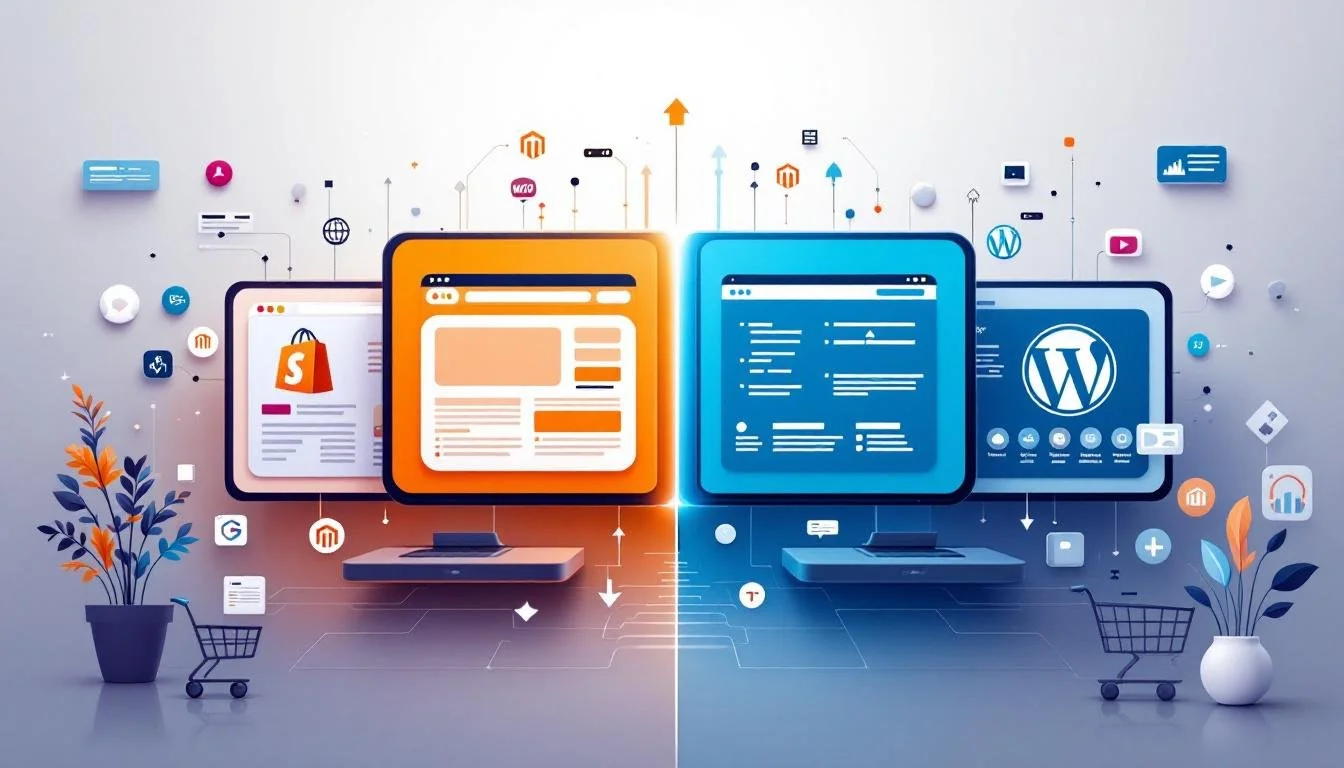Choosing an e-commerce platform: Shopify vs WooCommerce vs Magento
The choice of your e-commerce platform largely determines the success of your online store. With hundreds of platforms on the market, this decision can feel overwhelming. Shopify has established itself as a market leader, but how does it compare to alternatives such as WooCommerce, Magento (Adobe Commerce), and BigCommerce?
- Ease of use: Intuitive platform without technical skills, 24/7 customer service
- Flexibility: Hundreds of themes, 2000+ apps in the app store for any desired functionality
- Scalability: Plans from basic to enterprise level, grows with your company
- Security: PCI DSS-compliant, SSL certificates for all stores, excellent security measures
- SEO-friendly: Built-in SEO tools, easy meta-tag optimization, and SEO-friendly URL structure
In this comparison, we examine why Shopify consistently ranks at the top in platform comparisons and in which situations other solutions might be better. Whether you're a starting entrepreneur or considering migrating, this guide will help you make the right choice.
Why platform choice is crucial for your e-commerce success
Your e-commerce platform is the foundation of your online business. A wrong choice leads to technical problems, limited growth opportunities, and costly migrations later. Studies show that 40% of visitors leave a website if it takes longer than 3 seconds to load - performance is directly determined by your platform choice.
“Shopify is designed to be user-friendly for beginners, allowing you to create an online store with drag-and-drop templates without programming.”
Source: Shopify - What Is Shopify and How Does It Work
The right choice depends on factors such as technical knowledge, budget, growth ambitions, and marketing strategies. Let's compare the main players.
Shopify: the all-in-one market leader
Shopify has become the standard for e-commerce. The platform offers a complete hosted solution where you can focus on sales instead of technical matters.
Why Shopify excels
1. Ease of use without compromises Shopify's interface is designed for entrepreneurs, not developers. Your online store can be operational within hours thanks to visual editors and a clear step-by-step setup.
2. Performance and reliability With global Content Delivery Networks (CDN) and AI-driven server optimization, Shopify performs consistently well, even during peak periods such as Black Friday.
3. Scalable growth From startup to enterprise - Shopify grows with your business. Shopify Plus serves large brands with complex needs without a platform switch.
4. App ecosystem More than 6,000 apps in the Shopify App Store offer functionality for every need, from AI-driven marketing to advanced analytics.
“Shopify reigns supreme in e-commerce, offering unparalleled features unmatched by competitors, with an extensive app library of over 8,000 apps.”
Source: IntexSoft - Is Shopify the Best Platform for E-Commerce
WooCommerce: flexibility for WordPress experts
WooCommerce is not so much a platform as it is a plugin for WordPress. This approach offers maximum control but requires more technical knowledge.
Advantages of WooCommerce
1. Full ownership You have complete control over hosting, data, and customizations. No vendor lock-in as with hosted platforms.
2. SEO-friendly WordPress' strong SEO foundations give WooCommerce an advantage in search engine optimization.
3. Cost considerations The plugin itself is free, but hosting, security, and maintenance are at your own expense.
Challenges of WooCommerce
1. Technical complexity Hosting, updates, security, and performance optimization require expertise or external help.
2. Hidden costs Free doesn't mean cheap. Hosting, premium plugins, and development work can be expensive.
Magento (Adobe Commerce): enterprise powerhouse
Magento focuses on large enterprises with complex e-commerce needs. The platform offers unprecedented customizability but requires substantial resources.
When Magento makes sense
1. Enterprise scale For companies with millions of products and international operations, Magento offers the necessary robustness.
2. B2B functionality Advanced B2B features such as custom pricing, approval workflows, and company accounts are built-in.
3. Multi-store management Manage different brands, countries, and currencies from a single installation.
Magento limitations
1. Complexity and costs Implementation, maintenance, and license costs make Magento inaccessible to smaller companies.
2. Development overhead Virtually all adjustments require developers, which increases time and costs.
BigCommerce: the underdog with potential
BigCommerce positions itself as a Shopify alternative with more built-in features and no transaction fees.
BigCommerce strengths
1. Built-in features Many functionalities that require apps on Shopify are standard in BigCommerce.
2. No transaction fees All payment gateways without extra costs, which makes a difference with large volumes.
3. API-first architecture Flexibility for headless commerce and custom integrations.
BigCommerce limitations
1. Smaller ecosystem Fewer than 1,000 apps versus 6,000+ on Shopify limits expansion possibilities.
2. Steeper learning curve More complex than Shopify due to technical interface and many options.
“Companies making $1M-500M in revenue grow an average of 126% year-over-year on Shopify Plus, which is 690% above the e-commerce industry average.”
Source: Shopify Plus - Enterprise Ecommerce Platform
Platform comparison: the facts
Cost overview
Shopify: €27-€267/month, predictable costs
WooCommerce: Variable (hosting €10-50, plugins €50-150/year)
Magento: Free open source, Enterprise from €22,000/year
BigCommerce: €27-€267/month, no transaction fees
Setup time
Shopify: Hours to days
WooCommerce: Days to weeks
Magento: Weeks to months
BigCommerce: Days
Technical knowledge required
Shopify: Minimal
WooCommerce: Medium to high
Magento: High
BigCommerce: Low to medium
The decision matrix: which platform suits you?
Choose Shopify if:
You want to get online quickly without technical headaches
Predictable costs are more important than absolute control
You focus on performance marketing and growth
A robust app ecosystem is crucial
Choose WooCommerce if:
You already use WordPress and have technical knowledge
Full control over data and adjustments is a priority
SEO and content marketing are your main strategy
Budget flexibility is important
Choose Magento if:
You are a large enterprise with complex B2B needs
Unlimited customization is required
You have substantial development resources
Multi-store operations are crucial
Choose BigCommerce if:
You want built-in features without apps
Avoiding transaction costs is important
You want technical flexibility with less complexity than Magento
“With the best converting checkout on the internet, an AI commerce expert, and deep shipping discounts, Shopify helps businesses deliver the ultimate shopping experience to customers everywhere.”
Source: Shopify - What Is Shopify and How Does It Work
E-commerce trends influencing platform choice
AI and automation
Shopify leads in AI integration with features like automatic product descriptions and intelligent inventory management. For companies that want to use AI for growth, Shopify offers the most possibilities.
Headless commerce
Magento and BigCommerce excel in headless architectures, but Shopify Plus also offers strong headless capabilities for enterprise customers.
Social commerce
Shopify's integrations with Instagram, TikTok, and Facebook are the most extensive, crucial for modern social commerce strategies.
Migration considerations
Switching platforms is possible but complex. Professional e-commerce support can smooth the process and prevent data loss.
Migration tools
Cart2Cart: Automated migration between platforms
LitExtension: Specialized migration service
Shopify data import: Built-in import tools
Performance and speed comparison
Website speed directly determines your conversion rate and SEO ranking. The platforms score differently here:
Shopify performance
Optimized servers worldwide
Automatic caching and CDN
AI-driven resource allocation
Average loading time: 1.3 seconds
WooCommerce performance
Depending on hosting choice:
Good hosting (SiteGround, WP Engine): Comparable to Shopify
Budget hosting: Significantly slower
Optimization plugins required for best performance
Magento performance
Powerful but resource-intensive
Requires specialized hosting
Excellent for large catalogs
Setup and tuning crucial for good speed
Security and compliance
E-commerce security is non-negotiable. Data breaches cost an average of €4 million and can ruin your business.
Shopify security
PCI DSS Level 1 compliance standard
SSL certificates included
24/7 security monitoring
Automatic updates
WooCommerce security
Dependent on hosting provider
SSL and PCI compliance via third-party
Regular updates required
Own responsibility for security
ROI and total cost of ownership
Shopify TCO (3 years)
Platform costs: €1,000-9,600
Apps: €1,800-7,200
Development: €0-15,000
Total: €2,800-31,800
WooCommerce TCO (3 years)
Hosting: €360-1,800
Plugins: €300-2,700
Development: €3,000-25,000
Maintenance: €1,800-10,800
Total: €5,460-40,300
Support and documentation
Shopify support
24/7 chat, phone and email
Extensive knowledge base
Shopify Academy training
Shopify Experts directory
WooCommerce support
Community forums
Extensive documentation
Third-party developer support
24/7 chat for premium users
The quality of support can make the difference between success and frustration, especially for non-technical users.
Future-proofness
Shopify innovation
Aggressive AI integration
AR/VR commerce features
Regular platform updates
Strong financial position
Open source advantages
WooCommerce and Magento benefit from open source development:
Community-driven innovation
No vendor lock-in
Long-term availability
Best practices for platform selection
Start with your goals: Define success for the next 3-5 years
Assess your team: What technical expertise is available?
Calculate total costs: Look beyond monthly platform fees
Test thoroughly: Use free trials and demos
Plan for growth: Choose a platform that grows with you
Conclusion: the smart choice for 2025
Shopify remains the best choice for most companies in 2025. The combination of ease of use, performance, scalability, and ecosystem makes it the safest bet for growing businesses.
WooCommerce is excellent for WordPress experts who want complete control and prioritize SEO. Magento serves enterprise clients with unlimited budgets and complex needs. BigCommerce offers an interesting alternative for specific use cases.
For Dutch SMEs that want to grow quickly through online marketing and e-commerce optimization, Shopify remains the logical choice. The platform eliminates technical obstacles so you can focus on what really matters: your customers and growth.
Need help with your platform choice or migration? Book a free strategy session to discuss the best approach for your situation.

🚀 More leads, higher conversion, better ROI
This article gave you insights. Now it's time for action. Whether you want to build a profitable webshop, generate more revenue from performance marketing or SEO, or grow with AI-marketing - we'll help you move forward concretely.
💬 Discuss your challenge directly with Frederiek: Schedule a free strategy session or send us a message
📧 Prefer to email? Send your question to frederiek@clickforest.com or call +32 473 84 66 27
Strategy without action remains theory. Let's take your next step together.
Frequently asked questions about e-commerce platforms
-
Yes, migration is possible but complex. Professional support minimizes risks and data loss. Plan migrations carefully and test thoroughly.
-
WooCommerce has an advantage due to WordPress' SEO power. Shopify offers good SEO tools, but WooCommerce gives more control over technical optimization.
-
Shopify is transparent in pricing. Extra costs come from apps, premium themes, and potentially custom development. WooCommerce seems cheaper, but hosting, plugins, and development can be more expensive.
-
Shopify Plus and Magento are both excellently scalable. Shopify Plus offers easier scaling, Magento more control. WooCommerce scales well with the right hosting.
-
Minimal. Shopify is designed for entrepreneurs without a technical background. Basic adjustments are simple; more complex changes may require developers.
-
Shopify with 6,000+ apps versus under 1,000 for WooCommerce and BigCommerce. Quantity and quality make Shopify's ecosystem superior.
-
Yes, all platforms support dropshipping. Shopify has the most integrated dropshipping solutions; WooCommerce offers more flexibility.
-
Shopify completely takes care of security with PCI compliance and 24/7 monitoring. With WooCommerce, you are responsible for security yourself.
-
Yes, but quality varies. Shopify themes are mobile-optimized by default. With WooCommerce, it depends on the theme choice.
-
All platforms support custom domains. Setup differs per platform but is possible everywhere.
Sources and references
E-commerce platform comparisons:
Website Builder Expert: "Shopify vs WooCommerce vs BigCommerce comparison 2025" - https://www.websitebuilderexpert.com/ecommerce-website-builders/comparisons/shopify-vs-woocommerce-vs-bigcommerce/
Digital Silk: "Magento vs. Shopify vs. WooCommerce comparison guide" - https://www.digitalsilk.com/digital-trends/magento-shopify-woocommerce/
The Commerce Shop: "Shopify vs WooCommerce speed and performance comparison 2025" - https://www.thecommerceshop.com/blog/shopify-vs-woocommerce-speed-performance-2025/
Market research and statistics:
eCom Capital: "Shopify vs WooCommerce 2025 comparison guide" - https://www.ecomcapital.com/blog/shopify-vs-woocommerce-what-is-better-in-2025
Analyzify: "Shopify vs WooCommerce detailed comparison 2025" - https://analyzify.com/hub/shopify-vs-woocommerce
Aureate Labs: "Shopify vs WooCommerce platform analysis" - https://aureatelabs.com/blog/shopify-vs-woocommerce/
Performance and technical aspects:
WPBeginner: "Shopify vs WooCommerce expert comparison" - https://www.wpbeginner.com/opinion/shopify-vs-woocommerce-which-is-the-better-platform-comparison/
TechRadar: "Magento vs WooCommerce vs BigCommerce vs Shopify analysis" - https://www.techradar.com/features/magento-vs-woocommerce-vs-bigcommerce-vs-shopify











